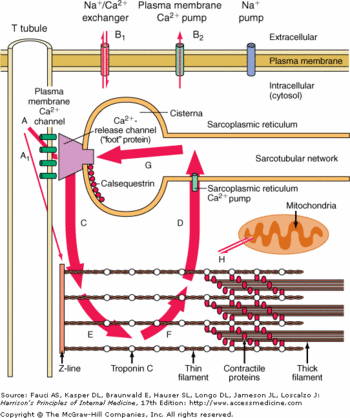Sandbox Reserved 820
From Proteopedia
(Difference between revisions)
| Line 25: | Line 25: | ||
Inside the sarcoplasmic reticulum lumen, CASQ2 polymerizes to form <scene name='56/568018/Dimer/1'>homodimers</scene>, homotetramers and homooligomers. | Inside the sarcoplasmic reticulum lumen, CASQ2 polymerizes to form <scene name='56/568018/Dimer/1'>homodimers</scene>, homotetramers and homooligomers. | ||
There are two types of dimerisation: the front-to-front form and the back-to-back form. | There are two types of dimerisation: the front-to-front form and the back-to-back form. | ||
| - | The front-to-front form is stabilized by intermolecular interactions between the α2 helix of the domain I of each | + | The front-to-front form is stabilized by intermolecular interactions between the α2 helix of the domain I of each CASQ2. The intermolecular salt bridges are between Glu 55 and Lys 49. This dimerisation induces the formation of an electronegative pocket which involves these amino acids: for the first CASQ2 Glu 39, Glu 54, Glu 78, Glu 92, Asp 93 and Asp 101 and for the second CASQ2 Glu 199, Asp 245, Asp 278, Glu 350 and Glu 348. <!--Mettre du VERT --> |
The back-to-back form is stabilized by intermolecular interactions between the α4 helix of the domain II and the α3 helix of the domain I. The intermolecular salt bridges are between Glu 215 and Lys 86, Glu 216 and Lys 24, Glu 169 and Lys 85. There is also a hydrogen bond between Ala 82 and Asn 22. This dimerisation induces a very electronegative pocket at the C-terminal region which enables the binding of Ca2+. | The back-to-back form is stabilized by intermolecular interactions between the α4 helix of the domain II and the α3 helix of the domain I. The intermolecular salt bridges are between Glu 215 and Lys 86, Glu 216 and Lys 24, Glu 169 and Lys 85. There is also a hydrogen bond between Ala 82 and Asn 22. This dimerisation induces a very electronegative pocket at the C-terminal region which enables the binding of Ca2+. | ||
| Line 34: | Line 34: | ||
== Calcium Binding == | == Calcium Binding == | ||
| - | Each monomere of | + | Each monomere of CASQ2 can bind between 18 to 50 Ca2+. The Ca2+ ions bind to two or more acidic amino acids like Glutamate or Aspartate. These amino acids are mainly outside the CASQ2 or in the C-terminal region. When CASQ2 form homomeres, Ca2+ can bind in the electronegative pocket due to the front-to-front form and back-to-back form. |
| - | Ca2+ is not the only ion which can bind to the | + | Ca2+ is not the only ion which can bind to the CASQ2. One of them is Mg2+. The affinity is for Mg2+ is lower than the affinity for Ca2+ however the number of Ca2+ decrease. Another ion is H+. When the pH is low, more H+ will bind to the acidic amino acids and they can not bind Ca2+ anymore. |
<!-- Source: Calsequestrin and the calcium release channel of skeletal and cardiac muscle (Beard et Al., 2004) Lien: http://www.ncbi.nlm.nih.gov/pubmed/15050380 --> | <!-- Source: Calsequestrin and the calcium release channel of skeletal and cardiac muscle (Beard et Al., 2004) Lien: http://www.ncbi.nlm.nih.gov/pubmed/15050380 --> | ||
Revision as of 16:36, 31 December 2013
| This Sandbox is Reserved from 06/12/2018, through 30/06/2019 for use in the course "Structural Biology" taught by Bruno Kieffer at the University of Strasbourg, ESBS. This reservation includes Sandbox Reserved 1480 through Sandbox Reserved 1543. |
To get started:
More help: Help:Editing |
| |||||||||||

